Page content
Astronomers and Stargazers
Eyeing a Heliocentric Heaven for Planets, Portents, and Horoscopes
by Anthony F. Aveni
Online Extras
Sidebar: Of Lenses and Tinderboxes
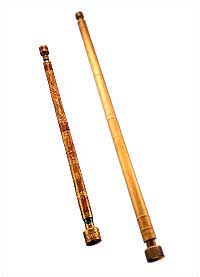
Galileo got wind of a new magnifying lens from Holland and set to building telescopes. On the left is a replica of one, which magnified fourteen times and allowed a partial view of the moon, enough for him to see craters there as well as Jupiter's moons. On the right is a replica of another Galilean telescope, which magnified twenty-one times. Scientific observation of the skies with telescopes paralleled a resurgent interest in astrology during the seventeenth century. Science and superstition coexisted easily for a time.
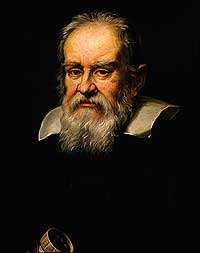
Sustermans's 1636 portrait of Galileo , whose observations of the heavens changed conceptions of the universe.
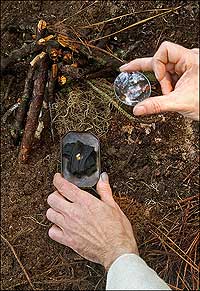
A lens like the one found at Jamestown could have been used in telescopes but also to fire tinder with a char cloth in the tinderbox.
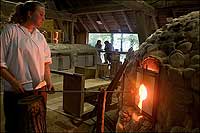
A glass-making factory from the seventeenth century, here re-created for visitors at Jamestown Settlement, was among Virginia's first industries. Remnants of the original ovens survive at Historic Jamestowne. There is no direct evidence that its workers made lenses.
View additional images of the glass-making factory. Image 1, Image 2, Image 3, Image 4, Image 5, and Image 6.
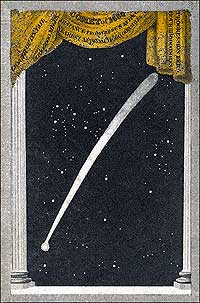
Comets, like this 1680 one in a contemporary English illustration, were believed portents of evil times: floods, earthquakes, violence in human affairs.
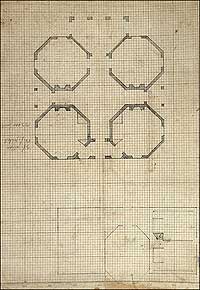
Jefferson's plan for an observatory at the University of Virginia yielded little more than a building.
From the remains of a Confederate earthwork that covers part of what once was seventeenth-century James Fort, archaeologist Carter Hudgins unearthed a round, dirt-encrusted, clear glass lens. The disk had reached the Americas surprisingly early, resting in the sandy soil of what once was Virginia's only seaport for time untold until Hudgins recovered it September 21, 2004. Exactly how the lens was used, and where it came from, neither he nor other archaeologists could say. Curiously, Jamestown—as James Fort became—had a glassmaking industry early on. Could the lens have been part of a seventeenth-century navigator's telescope? If it was, its age would be surprising. But the discovery may says something about the beginnings of astronomy in the American colonies—a science the next century pursued by Benjamin Franklin and Thomas Jefferson, among others.
The founding of Jamestown and the invention of the telescope happened in the same generation. In 1608, the year after Captain John Smith and company built the fort, Galileo got word in Italy that a lens maker in Holland, probably Antonie van Leeuwenhoek, had built an "optic reed . . . a certain device by means of which all things at a very great distance can be seen as if they were nearby." Galileo was one among a host of individuals who inquired about the gadget. What set him apart from his colleagues was that he was clever enough to use diplomatic channels to acquire the recipe for constructing one. He obtained a pair of spectacle lenses—the term comes from lentil, the shape of which each piece of glass approximated—placed them at opposite ends of a hollow tube at the sum of their focal lengths, and fashioned his own spyglass. He turned it on the heavens and saw mountains on the moon, moons moving around Jupiter, and spots on the surface of the sun. His observations contributed to a sea change in how we understand the universe.
The first astronomical observation recorded in the colonies preceded the invention of the telescope. It happened in what was then Virginia but now is North Carolina during the early English attempts at colonizing Roanoke Island. In 1585 the English mathematician Thomas Harriot noted that several of the natives who had come in contact with the settlers mysteriously died. Though the cause was probably smallpox or measles, Harriot looked for an explanation in the heavens. He ruled out the possibility that a solar eclipse was to blame—probably the one of April 29, 1585, he witnessed on the way over—or that a comet thought to have appeared at the time the sickness took hold was responsible. But he mentions in his 1588 Briefe and True Report of the New Found Land of Virginia, a "perspective glasse whereby we shewed manie strange sights." Though we know Harriot would be among the early inquirers into the use of the telescope, these pretelescopic observations were likely made with a single magnifying lens.
To judge from the historical record, skywatching was extraordinarily popular in early America. By the middle of the seventeenth century the colonies, particularly New England's, began to generate a spate of astronomical almanacs to aid stargazers in the scientific pursuit of celestial phenomena. They contained moon phases, tide tables, planting times, and the setting of religious holidays, along with the chronologies of world history, poems, and essays on the workings of the celestial sphere.
Why this New World interest in the sky? It was part of the European Age of Enlightenment, which spawned a generation of hobbyists. People collected rocks, plants, bugs, and they observed the stars. Such scientific observation was justified by scriptures. Psalms 111:2: "Great are the works of the Lord, studied by all who have pleasure in them./" Job 36:24: "Remember to extol his work, of which men have sung. All men have looked on it; man beholds it from afar."
Two developments in seventeenth-century thought contributed to the celestial craze.
The ancient Greek model of the earth-centered universe, after reigning for 1,500 years, was being overturned in favor of a sun-centered model. The old Ptolemaic geocentric model featured a fixed, immovable world surrounded by spheres on which each of the planets moved, the whole of it encased in a crystalline orb of modest dimension that contained the stars. In his De Revolutionibus Orbium Coelestium, published in Poland in 1573, Nicolaus Copernicus knocked the world literally off its pivot by setting the earth in motion. His theory opened the depths of space to penetration by the optic reed when he proposed the heliocentric model of the solar system. And so the limitless universe we have come to know today was born with the colonies.
Astronomer and almanac maker Zachariah Brigden, a Harvard graduate from Connecticut, was among the early American proponents of Copernicanism. In 1659 he wrote about the revolution of the then-known six planets about the sun, as well as the revolution of the four satellites about Jupiter and the two about Saturn. He also wrote an essay that attempted to reconcile the new system with the doctrine of the scriptures.
The scientific battle between the geocentric and heliocentric systems raced across colonial college campuses with a fervor unmatched until the early twentieth-century debates on Darwin's theory of evolution. Thanks to Brigden and others, in 1671 a Harvard college class refused to read the geocentric-based textbook assigned them. Their protest resulted in the firing of their out-of-date instructor and the hiring of a new one.
A quite different system of belief also fueled the astronomy craze in the early colonies. Astronomy, the science of the stars, and astrology, the belief that the stars influence human affairs, have always been allied, not just in Western culture but also in China, in ancient Egypt—even among the Pre-Columbian cultures of North and South America.
Though the scientific Renaissance helped sever the bond between the Siamese-sister disciplines, the mid-seventeenth century also witnessed an inexplicable backlash that ushered in a resurgence of astrological beliefs. The appearance of three great comets—in 1664, 1680, and 1682—undoubtedly contributed to the trend.
Thought to be poisonous exhalations from inside the earth, comets almost always were taken as warnings of disaster. Even scientific astronomers like John Danforth of Massachusetts, who correctly deduced that the great comet of 1664 passed well above the orbit of the moon, said that comets "most commonly ...are observed to precede if not portend great calamities." Repent your sins and pay heed to this sign from an angry God, he said. Puritan clergyman Cotton Mather offered much the same advice when the 1680 comet appeared. Readers may recall the deleterious effect Comet Hale-Bopp had on contemporary culture in 1997. Members of the Heaven's Gate cult, thinking the end of the world was near, attempted to hitch their wagon to the comet by donning clean costumes and drinking a poison potion. And previous returns of Halley's comet have brought predictions about the world, ranging from floods to wars to stock market crashes.
By their sudden appearance, comets seem to work against the order of things. Remember that Sir Isaac Newton's Principia, which would account for the strange orbits of comets with the theory of gravitation, had yet to make its debut in the scientific world.
The logic of astrology is straightforward, and we can understand why it might appeal to an unscientifically trained populace. For example, we know that there is a correlation between the tides and the appearance of the moon. Anyone who watches the moon's phases and times high and low tides cannot fail to detect it. A more careful observer will discover that the sun influences the tides as well—not to mention the weather and the seasons. So it is not a huge leap to imagine that the planets and the stars, being part of the firmament, also exert their influence. And that influence just might extend to the humors, our bodily fluids, that is to say, to the "tides in the affairs of men."
The astronomical almanacs from the 1660s to the end of the century prove that the colonists had a great desire to speculate on the mystical influence of the stars on the fate of mankind. For example, in Pennsylvania, almanacs generated by the Ephrata community charted the great comets along with conjunctions, or close passages by one another, of Jupiter and Saturn, and offered consequent astrological interpretations. The Pennsylvania Dutch were particularly interested in health beliefs and remedies for ailments timed by the phases of the moon. This started a trend picked up by Franklin, which appears in most modern Farmer's Almanacs: dispensing health information to accompany weather predictions and other practical astronomical information—even if they are not thought to be causally linked.
The colonial clergy offered few complaints about the telescopic observations that helped throw the world off its pivot. But astrological motivations for paying attention to the sky disturbed some. "If an Astrologer (as the blind man hits the mark) chance to praedict right once, more notice is taken of that then of his mistaking an hundred times over," said one reverend. Nevertheless, some of the most respected men of the cloth subscribed to astrology's principles and created almanacs as mouthpieces for astrological belief.
So great became the demand for information on skywatching that by the end of the seventeenth century Virginia, Pennsylvania, and New York joined New England in issuing astronomical almanacs and, as the accompanying interest further increased, in building bigger and better telescopes to turn to colonial skies. Telescopic users turned toward practical interests, such as more accurately determining longitudes and latitudes for the making of better surveys.
Though, relative to Europeans, the Americans lacked good quality instruments, libraries, and the general scientific community to promote dialog, they made contributions to astronomy. Arthur Storer, an astronomer and boyhood friend of Newton who immigrated to Maryland in the 1670s, and is mentioned in the Principia, conducted comet observations that helped Newton establish his gravitational theory. Though we know little about what kind of telescope Storer used, we do know that Thomas Brattle of Massachusetts employed a 3½-foot-long telescope to record observations of the comet of 1680. Fellow Massachusetts Bay citizen John Foster, a printer by trade, provided further observations. He measured the curved shape of the cometary orbit, which played a major role in Newton's theoretical deductions.
Foster, Brattle, and Storer, along with a host of seventeenth-century amateur American astronomers, would provide the impetus for the development of astronomy in the next century. At the beginning of the nineteenth century, astronomy in the United States got a big boost from Thomas Jefferson. When he founded the University of Virginia in 1819, instruction in astronomy was among the earliest of his plans for the curriculum. Not content simply to seek the best professors to build the courses, Jefferson devised plans to erect the first observatory in the nation. He also proposed building its first planetarium—the university's Rotunda dome. A patriotic affair, it would "be painted sky blue and spangled with gilt stars in their position and magnitude copied exactly from any selected hemisphere of our latitude." It was to feature a rope and pulley system so that the instructor could access any part of the dome to point out the stars—praise the inventor of the laser pointer teachers employ today.
But Jefferson's planetarium never came to fruition, and his plan for the observatory fared only slightly better. Though he got the building erected—an octagon-shaped structure twelve feet across, partially built by 1828—he died before its intended optical inhabitant could be installed. Though that building fell into ruin, the university got its observatory by the 1830s, by which time the federal government had opened the U. S. National Observatory. Soon colleges all over the states erected observatories, and astronomy took its place as one of the most popular courses in the American university.
A curiosity about astronomy in America is that above all the other sciences, it has retained its status as the most pursued scientific avocation for laypeople. Today comets are discovered largely by amateurs, and amateur observations of variable stars and supernovae are communicated throughout the professional scientific community. In no other scientific endeavor is the relationship between amateur and professional more tightly bonded. Two amateur astronomy magazines boast a readership exceeding one hundred thousand. All across the country astronomy clubs meet at their own observatories and organize star parties at which they display a magnificent and diverse array of instruments built by amateurs, many of whom have started from scratch by grinding and polishing their own mirrors. Despite the lure of television sports and the Internet, not to mention the interference of bright city lights, backyard skywatching is alive and well in America—perhaps an avatar of that old telescope lens unearthed from the Jamestown turf on which the English settlers stood.
Anthony Aveni, is the Russell B. Colgate Professor of Astronomy and Anthropology, serving in the department of physics and astronomy and the department of sociology and anthropology at Colgate University. He helped develop the field of archaeoastronomy, and his research in the astronomical history of the Maya Indians of ancient Mexico puts him among the founders of Mesoamerican archaeoastronomy. He contributed to the summer journal an article on Powhatan calendar keeping. Roger Williams is a Research Support Specialist, Colgate University.
